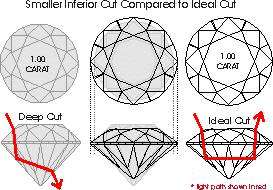|
Learn
To Identify the Common Heavy or Deep Cut Diamonds:
Diamonds are frequently cut for weight retention rather
than to produce maximum brilliance. These �undersize
diamonds� often weigh more than if they were cut correctly
and can therefore can be sold for for a larger profit.
 For
example: an ideal or very fine cut one carat diamond
measures 6.4 to 6.5 millimeters in diameter. If
you were to measure the diameters of most one carat
diamonds on the market today, you would find many to
measure between 5.9 and 6.3 millimeters. For
example: an ideal or very fine cut one carat diamond
measures 6.4 to 6.5 millimeters in diameter. If
you were to measure the diameters of most one carat
diamonds on the market today, you would find many to
measure between 5.9 and 6.3 millimeters.
These 1.00 carat, inferior
cut �undersize diamonds� are no larger in diameter than
ideal or fine cut diamonds which weigh 0.75 to 0.99
carats, and they exhibit significantly less brilliance.
We encourage you to choose a diamond that has ideal
to very fine cut. |